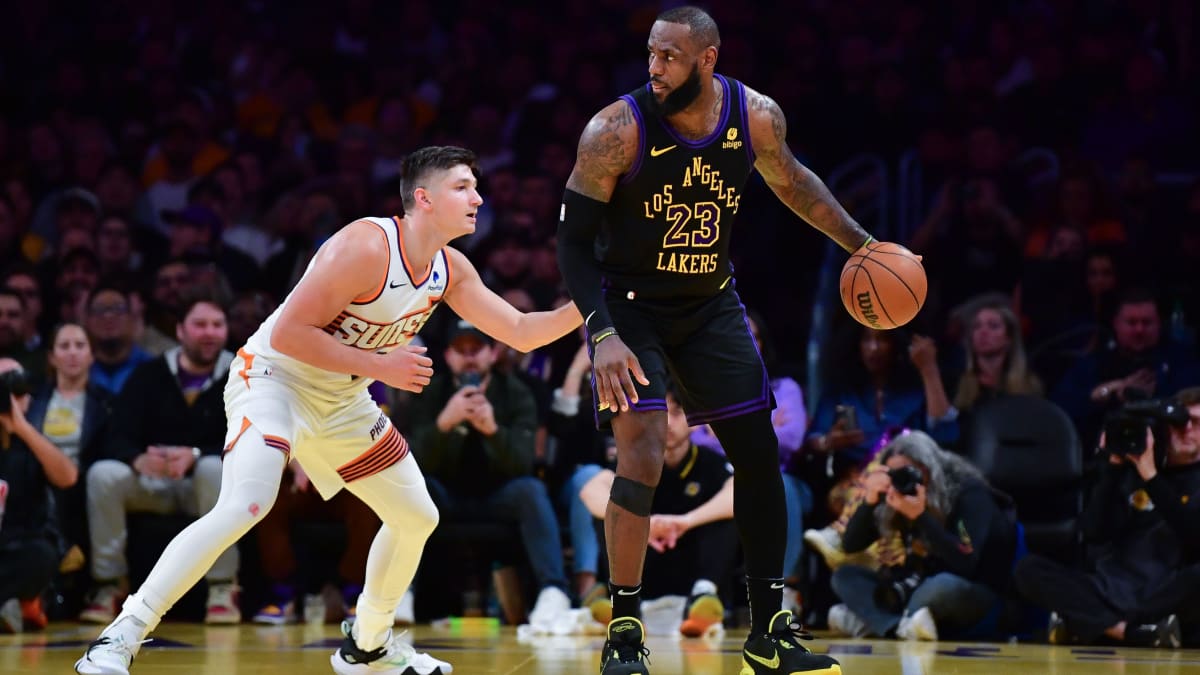Before we get all anecdotal, before we dig up the complaints and criticisms of the NBA’s inaugural in-season tournament, before we address the future of the neon-red courts or argue over alternatives to tiebreakers decided by point differentials, let’s state the obvious: The in-season tournament has been an unqualified success.
Just look at the numbers. Local viewership for group-play games was up 20% from games played last November. National games shot up 26%. League Pass viewership for the seven group-play nights increased by 25%. The league’s average attendance (18,206) was the highest for November, while the NBA’s app and social channels had their best first month of the season (3.9 billion video views) ever.
“From our perspective,” says Evan Wasch, the NBA’s executive vice president of basketball strategy and analytics, “the tournament has been incredibly successful.”

Gary A. Vasquez/USA TODAY Sports
Players like it. LeBron James has noted the competitiveness of in-season tournament games. Draymond Green said games had a playoff-like intensity. On TNT, Stan Van Gundy—who will never be confused for a company man—said, “NBA basketball has never been more fun in November and early December.” Before leading his team into their quarterfinal against the Lakers, Suns coach Frank Vogel said, “Whatever they thought it was going to do from an excitement standpoint, I would say it’s times 100.”
This is what the NBA was looking for. Energy. Excitement. A reason for its fan base to care about the first 20 games of an 82-game season. And whether it’s winning the NBA Cup or collecting the $500,000 prize that comes with it, players are invested. Consider the passion the Pacers played with Monday against Boston. Or the intensity of Lakers-Suns on Tuesday night. The league addressed end-of-season lethargy with the play-in tournament, which effectively opened up four more postseason spots. The in-season tournament has done the same for the beginning of it.
“When we first started this people said, ‘What are you going to be looking for to decide whether it’s something that you’ll think will be successful and you’ll want to move forward?’” Adam Silver told SiriusXM NBA Radio. “And I said, most importantly, let’s look to the competitiveness of the players, the enthusiasm on the floor, the buy-in. And we’re getting that in spades.”
Silver, of course, was the driving force behind the in-season tournament. Globally, in other sports, in-season tournaments (such as the UEFA Champions League, in which the top soccer teams in Europe compete, and the various soccer domestic cups, in which teams from all levels compete in a one-and-done format) are fixtures on the calendar. Successful ones. In meetings over the years, Silver believed in a future in which the in-season tournament might gain the status of a Wimbledon or an FA Cup. Win four majors in tennis, it’s a career Grand Slam. Win your soccer league title, the Champions League and your domestic cup and it’s The Treble. Win the Finals and the in-season tournament, it’s The Double.
The in-season tournament will evolve, of course. A full autopsy won’t begin until next week, says Wasch, but there are front-burner issues. The tournament courts are polarizing. The original purpose of the splashy-colored floors was educational. “That when you’re launching something new like this, to have it be immediately clear to players, teams, fans, both in the arena and watching on broadcast, that something different was taking place,” says Wasch. The league also wanted to create something “visually arresting” that would spark a conversation. On both counts, the NBA succeeded.
“We fully accept and appreciate that there were those who aesthetically maybe didn’t like the visuals of the courts,” says Wasch. “And that’s fine. It’s a bit like art. It’s never going to be universally pleasing to everyone.”
Using point differentials as a tiebreaker has tested the unwritten rule against running up the score. That has led to some tense moments. Pascal Siakam launching a three in the closing seconds of a win over Chicago with the Raptors up 12. Joe Mazzulla explaining to Billy Donovan why Boston hacked Bulls big man Andre Drummond with a 32-point lead. Silver shrugged at some of the criticism—“I’ve already heard from some players and some coaches who say, I never got it, like, we should all keep playing,” said Silver—while acknowledging that when it comes to potential changes “certainly that’s one we will look at.”
“We’re absolutely open to alternatives,” says Wasch. “In terms of the tiebreakers, I think one of the things we would look to though is still trying to keep as many of the advancement scenarios tied to performance in the tournament itself. People for example suggest, ‘Well, why don’t you use a team’s record outside of the tournament as a tiebreaker?’ And the thought here is that this is supposed to be a separate competition from the regular season. Whether there are other measures we could use to break those ties, which are inevitable when you only have four group-play games, that remains to be seen.”
There will be other tweaks. Fans don’t really understand how group play works. The league will work on that. The NBA Cup is a very generic name. It will work on that. The in-season tournament could look different next season. But there will be one next season. And that suits most players just fine. Addressing reporters after Boston’s loss to Indiana, Jayson Tatum was visibly frustrated.
“I wanted to f---ing go to Vegas,” Tatum said.
Maybe next year.







